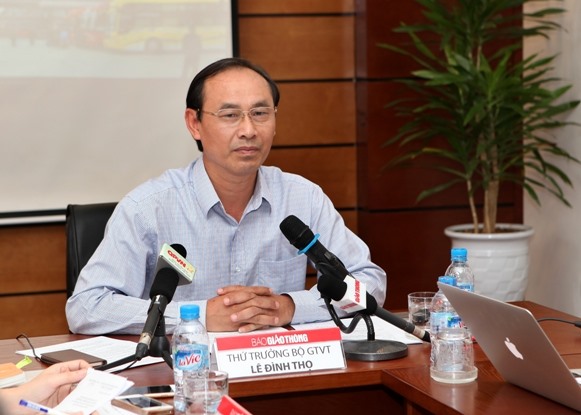 Opinion
Opinion

Deputy Minister of Transport Lê Đình Thọ talks to the Vietnam News Agency about some localities’ proposals to build new airports and the issue of air fare management in the past.
 |
| Lê Đình Thọ. — Photo tcnn.vn |
Deputy Minister of Transport Lê Đình Thọ talks to the Vietnam News Agency about some localities’ proposals to build new airports and the issue of air fare management in the past.
The authorities of Bà Rịa - Vũng Tàu Privince have agreed to support a business investment project to build the Lộc An Airport as a specialized aerodrome, which will be used exclusively for air transport to and from the Hồ Tràm complex entertainment resort. What is your view of the proposal?
According to the Master Plan on Transport Development for the period up to 2020 with vision to 2030, Bà Rịa - Vũng Tàu Province would have only one airport – the Côn Đảo Airport. The Lộc An Airport Project is not included in the national airport network.
The Law on Civil Aviation of Việt Nam stated that specialised aerodrome means an aerodrome used only for the operation of general aviation or carrying passengers, baggage, cargo, parcels and mail which is not for public transport. Therefore, the Lộc An Airport can be used as an airport for non-scheduled flights (not public transportation) for the Hồ Tràm Complex Tourist Complex.
The authority to decide on the opening and closure of specialised airports and the view of the Ministry of Transport on this matter is prescribed in the Việt Nam Civil Aviation Law: "The Ministry of Defence shall decide on the opening or closure of specialised airports after consulting with the Ministry of Transport ".
If the Lộc An specialised aerodrome has the potential and need to carry out non-routine flights for local tourism and socio-economic development, the Ministry of Transport supports the proposal. We suggested that Bà Rịa - Vũng Tàu Province work with the Ministry of Defence to approve the planning of Lộc An special airport as a basis for localities and investors to invest.
The Ministry of Transport will assign the Civil Aviation Administration of Việt Nam and related agencies to coordinate with the Ministry of Defence’s agencies in examining the proposal to open Lộc An Airport.
Currently, besides major airports such as Tân Sơn Nhất, Nội Bài and Đà Nẵng, many airports are not operating at full capacity, some are even said to be inefficient. Still, many provinces have proposed building local airports. Do these proposals disrupt the airport planning already approved by the government?
When assessing the efficiency of the exploitation of airports, the overall socio-economic efficiency must be taken into consideration. In some key areas, there are airports close to each other but the main purpose of planning these airports is not to exploit intra-regional routes but to expand and develop inter-regional markets.
When investors were making plans for airports in localities such as Vinh, Đồng Hới , Thọ Xuân, Tuy Hòa, Phú Cát, Pleiku, Buôn Mê Thuột and Côn Đảo, there were also many doubts and concerns about investment efficiency.
However, through the actual exploitation, these airports have achieved impressive growth (on average 15-20 per cent per year) and these airports have contributed significantly to the attraction of investment, meeting people’s travel demands as well as the general development of socio-economic strength, security and defence of the localities.
At present, there are some airports which are not financially efficient but the maintenance and development of airports in localities is still necessary because of the general economic development, socio-economic development of localities and national defence and security of the country.
In addition, the financial performance of airports should be assessed by the departure and arrival points from these airports. Although some airports have not achieved financial efficiency, their existence contributes considerably to major airports as transferring spots. Therefore, looking at the big picture, the whole network of airports is profitable and makes a proper annual contribution to the State budget.
According to aviation planning, by 2020 Việt Nam would have 10 international airports and 13 domestic airports. By 2030, Việt Nam would have 13 international airports and 15 domestic airports.
Therefore, in addition to putting into operation Vân Đồn International Airport, and starting the construction of Long Thành International Airport, from now until the years after 2020 we will study, prepare and build five new airports in Phan Thiết City, Sapa Town, Sơn La, Quảng Trị and Lai Châu provinces.
In order to ensure the socio-economic efficiency of these five airports, the investment timing of the airports will be carefully studied and analysed in the pre-feasibility study report.
In case a locality proposes the construction of an airport that is not in the planned aviation network approved by the Government, the Ministry of Transport can’t consider the investment.
Deputy Prime Minister Vương Đình Huệ had requested the Ministry of Transport to reconsider managing air fares and add the adjustment of aviation into its price control plan. How will the Ministry control air fares in the coming time?
The Ministry has asked relevant agencies within the sector to implement measures to stabilise airfares in particular and transport fares in general.
The ministry’s working team on price stabilising will analyse changes in cost to the transport sector in order to make a reasonable prices adjustment.
The ministry also co-operates with the finance ministry and the General Statistics Office and Ministry of Planning and Investment to evaluate the impacts on the customer price index so that the inflation rate could be put under control.
Besides, the Ministry of Transport has directed the Civil Aviation Administration of Việt Nam to intensify the inspection and supervision of the implementation of air transport service charge rates among airlines in accordance with the law. The ministry will also promptly issue recommendations to airlines on the adjustment of freight rates and additional charges to ensure the benefits of both passengers and airlines.
The Ministry of Transport is also issuing a circular regulating the price range of air transportation services on domestic flights, which is expected to be completed in 2018. — VNS




